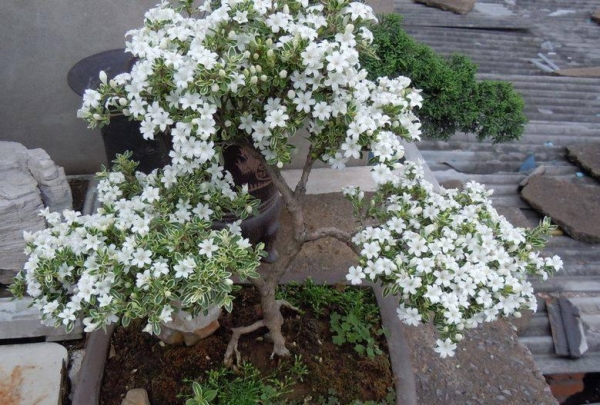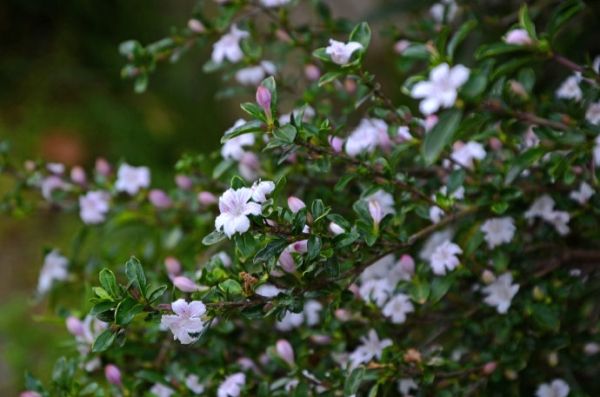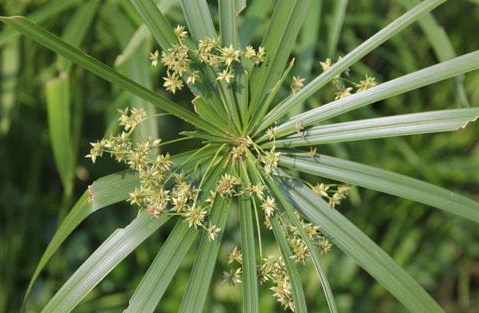Maintenance of snow in June
After the end of cutting, the maintenance in the later stage is also very important. In the early days, the cuttings are afraid of being exposed to the sun, so we have to build a shed to shade it in time, and then pay attention to watering so that the matrix is moist all the time, so as to make it easier for the cuttings to survive. After the cuttings survive, you can let it enjoy some light normally, but be careful that the light is not too strong.

Key points for the maintenance of June snow breeding points for attention
June snow, there is a very old legend, Dou E grievance is one of the most representative stories. The June snow in real life, like its name, is as pure and white as snow and is very beautiful. The snow in June must be taken good care of in order to see its most prosperous scene. June snow is wild in Liucheng and its mu areas of the Yangtze River in China, distributed in forests or streams, and mostly on shady slopes. Let's take a look at the breeding methods of June snow.
I. about the snow in June
June snow, a Siming, a Jasmine. Fine white flowers bloom in June, the tree is the smallest and the branches and leaves are sparse, so it can be used as a pot to play. Like light shade, afraid of the sun, there are many under the leaves and trees in the mountains. Spring planting, or Huangmei rain cutting, it is appropriate to pour shallow tea. It is a small evergreen shrub that blossoms in June. From a distance, it looks like snow in silver, like snow in June, elegant and lovely, hence its name. Most of them are wild in the mountains and forests and by the rocky banks of streams. For subtropical tree species, sexual preference for warm and humid climatic conditions and semi-overcast and semi-Yang, loose and fertile soil, good drainage soil, neutral and slightly acidic, cold resistance is not strong.
The snow in June is afraid of bright light. Like warm climate, but also slightly cold-resistant, drought-resistant. Like good drainage, fertile and moist loose soil, the environmental requirements are not high, the growth ability is strong. Born in a forest of miscellaneous trees by rivers or hills. June snow root, stem, leaf can be used as medicine. Light, slightly pungent, cool. Soothing the liver and relieving depression, clearing heat and dampness, detumescence and detoxification, relieving cough and resolving phlegm. For acute hepatitis, rheumatism, waist and leg pain, abscess, snakebite, spleen deficiency and diarrhea, infantile disease, eye nebula, intestinal carbuncle, rabies.
Sex like the sun, but also more resistant to shade, avoid the gale sun, high temperature and heat season should be shaded June thin white flowers, the tree is the smallest and branches and leaves sparse, there is a lot of escape, can do pot play. Like light shade, afraid of the sun, there are many under the leaves and trees in the mountains. Spring planting, or Huangmei rain cutting, it is appropriate to pour shallow tea. The temperature is not strict, it is evergreen in South China and semi-evergreen in Southwest China. The drought tolerance is strong, and the soil is not strict.
The snow blossoms in June, and the tree is the smallest with sparse branches and leaves. Like light shade, afraid of the sun, there are many under the leaves and trees in the mountains. Spring planting, or Huangmei rain cutting, it is appropriate to pour shallow tea. The temperature is not strict, it is evergreen in South China and semi-evergreen in Southwest China. The drought tolerance is strong, and the soil is not strict. Pot culture should use humus, loose and fertile, strong permeability of slightly acidic, moist culture soil, good growth.
Second, the culture method of June snow
1, transplanting pot: generally speaking, February to March is the best time for transplanting, of course, Meiyu season and late autumn season is also a good season. When transplanting, the pot chosen is purple sand basin and glaze basin, and the basin color should be dark, which can form a sharp contrast with the flower color. The basin soil is required to be sandy, which should be loose and rich in organic matter and good drainage. In addition, in the choice of fertilizer, pine needle soil, humus soil and peat can be mixed with each other, and about 10% rice husk ash should be added.
2. Water and fertilizer management: the water and fertilizer management of June snow should be suitable, not too dry or too wet, keep an appropriate amount of water in basin soil, reduce watering times in winter, and generally spray water on leaves in summer. In addition, April to May is the best time to apply fertilizer, which can be irrigated with 0.5% phosphate and potassium fertilizer, and can be re-fertilized in winter to irrigate thin organic fertilizer. Heavy fertilizer is a big taboo.
3. Light and temperature requirements: June snow likes sunshine, warmth, moisture and ventilation. Therefore, maintenance should be carried out in these conditions during the growing season. Summer should be properly shaded, must not be exposed to the sun, winter should be moved indoors, to maintain a certain temperature, such as 5 to 12 degrees Celsius.
4. Turning the basin and pruning: turning the basin every other year can make the soil more loose and suitable for plant growth. At the same time, the removal of the old soil and proper pruning of the roots can also improve its ornamental value. In winter, plastic pruning should be carried out, long and short branches should be trimmed, and sparse and dense branches should be trimmed, which can not only remove messy branches and leaves, improve the aesthetic sense of ornamental, but also cut off the branches and leaves of diseases and insect pests. At the same time, through heart-picking, sprouting, removing branches, etc., to maintain a certain shape, elegant and moving.
5: pest control: snow in June generally has fewer diseases and insect pests, with occasional aphids. At this time, you can use wind oil essence spray, you can kill aphids, but the concentration should not be too high, dilution 500 to 600 times is more appropriate. In addition, root rot sometimes occurs. At this time, it is irrigated with 800 times of Gen Fuling or 600-1000 times of 12% oleic acid copper EC and sprayed every other time for three times in a row.
Key points for the maintenance of snow in June
When it is hot and dry in summer, in addition to watering every day, sprinkle the foliage and nearby ground with clear water in the morning and evening to cool down and increase air humidity. Plants should be placed under the shade and should not be exposed to strong sunlight for a long time. After autumn, as the temperature drops, the amount of water should be controlled gradually and watered once every 2 to 3 days. In winter, move to a cold room or indoor room of not less than 0 ℃ to spend the winter, watering once every 20 to 30 days. If the room temperature is above 15 ℃, the leaves are evergreen, and water is watered once every 7 to 10 days. Keep moist air and give sunshine. Do not get cold during the severe cold, otherwise it is easy to die. Before leaving the room in March every year, the rotten leaf soil is used to change the basin, and the bottom of the basin is made of foot angle piece as base fertilizer.
Fewer diseases and insect pests. Occasional aphids can be killed with omethoate 1500 times liquid spray. The basic task of managing it is watering and fertilizing. The principle of watering, do not dry do not water, do not overpour, if the basin mouth is wet for a long time, resulting in root breathing difficulties, easy to rot the root to death. Pay attention to diligent fertilization, the application of rotten liquid fertilizer, no fertilization in summer, flowering can not be fertilized, so as not to grow out of shape. Tips should be picked from May to June, and new buds should be removed in July.
Potted flowers should be in a fixed position and should not be moved from east to west. June snow pays attention to light. In summer, it is necessary to shade the sun in the hot sun, keep ventilated, spray water to its leaves once or twice a day, and maintain air humidity. In cold winter, straw can be slightly bandaged (about 10 ℃) to avoid freezing to death. The diseases and insect pests of snow in June are usually shell insects. 40% omethoate 1000 to 1500 times or 25% imidophos 1000 to 1500 times can be sprayed to control the disease.
Finally, the above are the breeding methods and matters needing attention of June snow. Whether it is legend or reality, the snow in June has left a deep impression on people. And planting it indoors brings not only beauty but also bone-breaking fragrance. I hope everyone likes this plant and nurtures it well.
Key points for the maintenance of snow in June
Snow in June (broken leaves holly, stars in the sky)
Scientific name: Serissia foetida
Alias: broken leaf holly, white horse bone, Jasminum, Siming, June snow, one Miming, one Jasminum.
Families and genera: Rubiaceae, June snow genus
Distribution of origin: southeast Asia.
Key points of conservation: evergreen shrubs. Less than 1 meter tall, more branched, leaves small, flowers small, white or lavender. It is a good material for making bonsai plants, especially for miniature bonsai. Plant in small pots in peat soil or rotten leaf soil; change pots once every 2 to 3 years; fertilize once in 2 to 3 weeks during the growing period; require sufficient moisture and high air humidity; prefer semi-shady light and grow in shade in summer. Like the warm environment, the lowest overwintering temperature is about 5 ℃. The bonsai should be trimmed at least once or twice a year to maintain its original shape. Cultivated varieties with flowers and leaves and double flowers.
Commonly cultivated are Phnom Penh June snow (leaf edge golden yellow), variegated June snow and double June snow.
Garden applications: in southern gardens, they are often planted in open fields under forest canopies and bushes, while in the north, many potted plants are ornamental and spend the winter indoors. It is also a good bonsai material.
Efficacy: the whole plant is used as medicine, invigorating spleen and promoting dampness, soothing liver and activating blood circulation.
Propagation: cuttings.
Lighting: like strong light, not resistant to shade (sufficient light).
Moisture: growing in moist soil.
Temperature: slightly cold-resistant, able to withstand-5: 0 ℃ low temperature.
Humidity: medium relative humidity, 50% to 60%.
- Prev

The breeding mode of snow in June
The ramet method is usually carried out around the beginning of spring and March before sprouting, or at the end of autumn when it stops growing. The mother plant is dug out of the soil with roots and is divided into several small clumps with hands or scissors. Each clump should be transplanted into flowerpots with 3 branches and roots in the lower part. Scatter and insert to make use of open space
- Next

Water culture method of parasol grass
1. Water quality raise parasol grass can use lake water, river water, well water, sky fall water, tap water needs to rest for a day before it can be used, can not use mineral water. two。 Soak the root and the surface of the water at a distance of about 3 cm, not too deep. The root system can be pressed with pebbles to keep the plant stable. 3. Maintenance of high temperature in summer
Related
- Fuxing push coffee new agricultural production and marketing class: lack of small-scale processing plants
- Jujube rice field leisure farm deep ploughing Yilan for five years to create a space for organic food and play
- Nongyu Farm-A trial of organic papaya for brave women with advanced technology
- Four points for attention in the prevention and control of diseases and insect pests of edible fungi
- How to add nutrient solution to Edible Fungi
- Is there any good way to control edible fungus mites?
- Open Inoculation Technology of Edible Fungi
- Is there any clever way to use fertilizer for edible fungus in winter?
- What agents are used to kill the pathogens of edible fungi in the mushroom shed?
- Rapid drying of Edible Fungi

